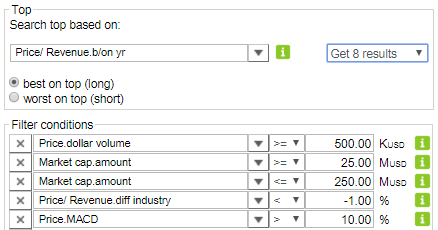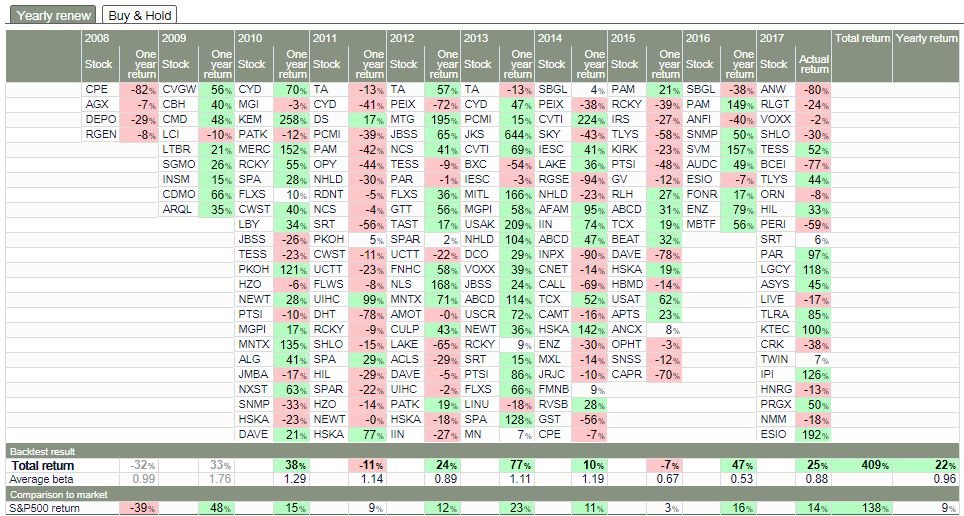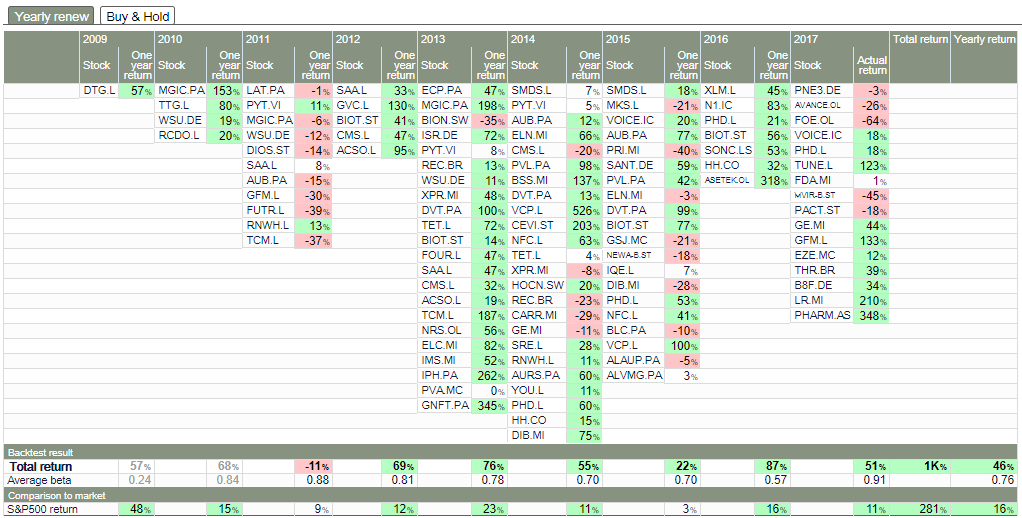Tiny Titans Screen
using Uncle Stock Screener
Creating a Tiny Titans screen in Uncle Stock requires only one variation from the standard set of criteria regardless of which world market is selected.
The core criteria for O'Shaughnessy's Tiny Titans are pretty basic: micro cap stocks with a favorable P/S valuation, and recent out-performance. Over-the-counter stocks are excluded.
Because it can be difficult to buy/sell thinly traded stocks, minimum trading liquidity (daily volume in terms of currency) is also specified.
Universe and Portfolio Size
One of the outstanding features of Uncle Stock is the variety of markets in which you can screen for stocks. Over 40 unique markets.
For this example, we will use the US market. Although not shown on the screen below, OTC stocks are excluded. Refer to the Uncle Stock review for info on selecting markets and exclusions.
The screen criteria are shown below. Per Tiny Titans requirements, the top stocks are selected using Price/Sales. This is both the ranking mechanism and a selection criteria.
Normally 25 stocks are selected. Instead of the "Get 8 results" shown below, we selected the default 24 result drop-down, since that is also the basis for the back-test. If more results are preferred, simply choose another default from the list.
Implementing the Tiny Titans screen
The Tiny Titans strategy looks for market cap between US $25 million and US $250 million.
In real life, market cap should be on an inflation adjusted basis, not an absolute basis. Since the market cap range was established by O'Shaugnessy in 2007, you should adjust the range to suit current market conditions. The published strategy did not address market cap weakness – only inflation adjusted market cap.
Price to Sales Ratio should be less than 1 by definition. And that is possible in Uncle Stock. But since Price to Sales is industry specific in many cases, an industry relative Price to Sales ratio is used for the screen.
Setting the minimum trading volume is a matter of personal preference, and to some extent, skill in trading stocks with minimal liquidity. For example, if the individual position sizes you plan are US $10,000 and the stock only trades US $250,000 per day, you may be a market mover. Choose wisely.
The screen is set at minimum liquidity of US $500,000 per day.
MACD is used for the momentum filter and must exceed 10%. Notice this can affect the number of passing companies. If you require more companies to pass the screen, this is the first variable to tweak.
Variations and Back-testing
Another feature that makes Uncle Stock one of the best available screeners, is the ability to back-test criteria variations to get a feel for actual performance.
So, instead of relying on published results and hoping a change will not impair the results, you can test your specific variation.
Baseline Performance
Using the criteria specified above, the back-test was run.
For each year since 2008, Uncle Stock selects up to 24 of the top ranked companies passing the screen. In this case, up to 24 companies based on their Price to Sales (Revenue) ratio. The top ranked stock is at the top of the list, then the next ranked stock, and so forth.
Those top companies are held for 1 year (just as O'Shaughnessy does in his published Tiny Titans screen).
After 1 year, selections for the next year replace the prior year holdings.
Notice, that in some cases there were fewer than 24 companies in the test. Those were years where you might lower the MACD limit to allow more companies to pass.
Most of us would be okay with the baseline 22% CAGR for 10 years.
And if you require a favorable Market Climate, you would have missed the carnage in 2008.
Variations
With the variety of markets offered in Uncle Stock, the most obvious variation is to select another market.
How about Europe instead of the US.
The 46% CAGR is excellent, but notice that in most years, there were fewer than 24 stocks passing the screen. It is unlikely you would take the capital for 20+ stocks and invest all of it in the 7 stocks that pass in 2016.
Again, this is just a starting point. To get more companies passing the screen is simply a matter of adjusting criteria limits or selecting other criteria or markets. Or even adjusting portfolio size to fewer positions.
NOTE: if the ticker is crossed out, it means the stock was included in the back-test, but is no longer trading.
Choosing India as the market resulted in a 43% CAGR. But, once again, there were years with less than 24 passing companies.
Other variations were tried and back-tested.
One variation replaced the MACD momentum filter with expected price growth resulting in a back-tested 24% CAGR.
Some of the other promising variations replaced the Price to Revenue ranking with scoring systems and the Price to Revenue criteria with other valuation ratios in the Tiny Titans screen criteria.
Summary
This implementation example of a Tiny Titans screen illustrates some fo the strengths of Uncle Stock.
If you decide to take the 2 week free trial, this is an easy strategy to implement and back-test.
To forward test, a test folio on FolioInvesting will track the 1 year performance of 20 passing stocks. No stocks will be changed for the year, but an unfavorable Market Climate will cause all positions to be closed.
For the current view of O'Shaughnessy Asset Management on a Micro Cap stock strategy (aka Tiny Titans).
-
101 Home
›
-
Strategies
›
-
Titans
›
-
Screeners
›
-
Uncle Stock
HOME | Site Policies | Contact Us | About Me | About Site | Site Map
Popular Pages
CANSLIM Strategy
Folio Investing
Economic Indicators
Portfolio123
Ranking Systems
New
We value your suggestions, comments, and questions.
Our goal is to make this site as useful as possible.
Contact Us
Thanks!
Stock screening tools and consistent, sustainable investing processes.
About Me
Why build a website instead of a blog?
About this site
April 2018


